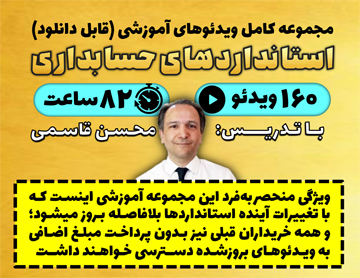کنترل سرمایهپذیر: سرمایهگذار زمانی بر سرمایهپذیر کنترل دارد که در معرض بازده متغیر ناشی از ارتباط با سرمایهپذیر قرار گرفته باشد یا نسبت به آن بازده از حق برخوردار باشد و از طریق تسلط بر سرمایهپذیر، توانایی اثرگذاری بر آن بازده را داشته باشد. (استاندارد حسابداری 39 صورتهای مالی تلفیقی (مصوب 1398))
 توضیحات دکتر محسن قاسمی درباره مفاهیم سهگانه کنترل، کنترل مشترک، و نفوذ قابل ملاحظه (اینجا کلیک کنید)
توضیحات دکتر محسن قاسمی درباره مفاهیم سهگانه کنترل، کنترل مشترک، و نفوذ قابل ملاحظه (اینجا کلیک کنید)
[ برای دریافت مجموعه کامل ویدئوهای آموزشی استانداردهای حسابداری 1400 اینجا کلیک کنید ]
کنترل
7. سرمایهگذار، صرفنظر از ماهیت ارتباط با یک واحد تجاری (سرمایهپذیر)، باید از طریق ارزیابی وجود کنترل بر سرمایهپذیر، تعیین کند که واحد تجاری اصلی است یا خیر.
8. سرمایهگذار زمانی بر سرمایهپذیر کنترل دارد که در معرض بازده متغیر ناشی از ارتباط با سرمایهپذیر قرار گرفته باشد یا نسبت به آن بازده از حق برخوردار باشد و از طریق تسلط بر سرمایهپذیر، توانایی اثرگذاری بر آن بازده را داشته باشد.
| [ شروط سهگانه کنترل ] |
|---|
9. بنابراین، تنها در صورت وجود تمام موارد زیر، سرمایهگذار بر سرمایهپذیر کنترل دارد:
|
10. سرمایهگذار هنگام ارزیابی وجود کنترل بر سرمایهپذیر، باید تمام واقعیتها و شرایط موجود را مورد توجه قرار دهد. اگر واقعیتها و شرایط، حاکی از تغییر یک یا چند عنصر از عناصر سهگانه کنترل مندرج در بند 9 باشد، سرمایهگذار باید وجود کنترل بر سرمایهپذیر را مجدداً ارزیابی کند. (به بندهای ب80 تا ب85 مراجعه شود).
11. دو یا چند سرمایهگذار، در صورتی بطور جمعی بر سرمایهپذیر کنترل خواهند داشت که ملزم باشند برای هدایت فعالیتهای مربوط، با یکدیگر همکاری کنند. در این موارد، از آنجا که هیچ یک از سرمایهگذاران نمیتوانند بدون همکاری دیگران، فعالیتهای مربوط را هدایت کنند، هیچ یک از سرمایهگذاران به تنهایی بر سرمایهپذیر کنترل ندارند. هر سرمایهگذار، منافع خود در سرمایهپذیر را طبق استانداردهای حسابداری مربوط، از جمله استاندارد حسابداری 40 مشارکتها (مصوب 1398)، استاندارد حسابداری 20 سرمایهگذاری در واحدهای تجاری وابسته و مشارکتهای خاص (تجدیدنظرشده 1398) یا استاندارد حسابداری 15 حسابداري سرمايهگذاريها به حساب منظور میکند.
تسلط
12. سرمایهگذار در صورتی بر سرمایهپذیر تسلط دارد که دارای حق بالفعلی باشد که به او توانایی فعلی برای هدایت فعالیتهای مربوط، یعنی فعالیتهای دارای اثر قابل ملاحظه بر بازده سرمایهپذیر را بدهد.
13. تسلط از حق نشأت میگیرد. برخی مواقع ارزیابی تسلط ساده است، مانند زمانی که تسلط بر سرمایهپذیر بطور مستقیم و تنها از طریق حق رأی ناشی از ابزارهای مالکانه مانند سهام به دست میآید و با در نظر گرفتن حق رأی سهامداری قابل ارزیابی است. در موارد دیگر، برای مثال زمانی که قدرت از یک یا چند توافق قراردادی ناشی میشود، این ارزیابی پیچیدهتر خواهد بود و مستلزم توجه به بیش از یک عامل است.
14. یک سرمایهگذار که از توانایی فعلی برای هدایت فعالیتهای مربوط برخوردار است، حتی در صورتی که هنوز از حق خود برای هدایت استفاده نکرده باشد، دارای تسلط است. شواهدی که نشان دهد سرمایهگذار فعالیتهای مربوط را هدایت کرده است، میتواند در تعیین اینکه او دارای تسلط است یا خیر، کمککند؛ اما این شواهد به خودی خود، برای تعیین اینکه سرمایهگذار بر سرمایهپذیر تسلط دارد یا خیر، کفایت نمیکند.
15. چنانچه دو یا چند سرمایهگذار، هر کدام دارای حق بالفعلی باشند که به آنها توانایی یکجانبه برای هدایت فعالیتهای مربوط متفاوت را بدهد، آن سرمایهگذاری بر سرمایهپذیر تسلط دارد که از توانایی فعلی برای هدایت فعالیتهای دارای بیشترین اثر بر بازده سرمایهپذیر، برخوردار باشد.
16. سرمایهگذار، حتی در صورتی که سایر واحدهای تجاری دارای حق بالفعلی باشند که بر اساس آن از توانایی فعلی برای مشارکت در هدایت فعالیتهای مربوط برخوردار شوند، برای مثال زمانی که واحد تجاری دیگر از نفوذ قابل ملاحظه برخوردار است، میتواند بر سرمایهپذیر تسلط داشته باشد. با وجود این، سرمایهگذاری که فقط دارای حق حمایتی است بر سرمایهپذیر تسلط ندارد (به بندهای ب26 تا ب28 مراجعه شود) و بنابراین، بر سرمایهپذیر کنترل ندارد.
بازده
17. چنانچه بازده سرمایهگذار که از ارتباط با سرمایهپذیر ناشی میشود، در نتیجه عملکرد سرمایهپذیر امکان تغییر داشته باشد، سرمایهگذار در معرض بازده متغیر ناشی از ارتباط با سرمایهپذیر قرار میگیرد یا نسبت به آن بازده از حق برخوردار میشود. بازده سرمایهگذار میتواند فقط مثبت، فقط منفی یا هم مثبت و هم منفی باشد.
18. اگرچه تنها یک سرمایهگذار میتواند بر سرمایهپذیر کنترل داشته باشد، اما اشخاص متعددی میتوانند در بازده سرمایهپذیر سهیم باشند. برای مثال، دارندگان منافع فاقد حق کنترل میتوانند در سود یا سایر منابع توزیعشده سرمایهپذیر، سهیم باشند.
ارتباط بین تسلط و بازده
19. سرمایهگذار زمانی بر سرمایهپذیر کنترل دارد که علاوه بر تسلط بر سرمایهپذیر و آسیبپذیری از بازده متغیر ناشی از ارتباط با سرمایهپذیر یا برخورداری از حق نسبت به آن بازده، بتواند با استفاده از تسلط خود، بر بازده ناشی از ارتباط با سرمایهپذیر تأثیر بگذارد.
20. بنابراین، سرمایهگذار دارای حق تصمیمگیری، باید تعیین کند که اصیل است یا نماینده. یک سرمایهگذار که طبق بندهای ب58 تا ب72، نماینده محسوب میشود، در صورت اعمال حق تصمیمگیری تفویضشده به آن، بر سرمایهپذیر کنترل ندارد.
Control of an investee: An investor controls an investee when the investor is exposed, or has rights, to variable returns from its involvement with the investee and has the ability to affect those returns through its power over the investee - IFRS 10 Consolidated Financial Statements
Control
An investor, regardless of the nature of its involvement with an entity (the investee), shall determine whether it is a parent by assessing whether it controls the investee. | 5 |
An investor controls an investee when it is exposed, or has rights, to variable returns from its involvement with the investee and has the ability to affect those returns through its power over the investee. | 6 |
Thus, an investor controls an investee if and only if the investor has all the following:
| 7 |
An investor shall consider all facts and circumstances when assessing whether it controls an investee. The investor shall reassess whether it controls an investee if facts and circumstances indicate that there are changes to one or more of the three elements of control listed in paragraph 7 (see paragraphs B80–B85). | 8 |
Two or more investors collectively control an investee when they must act together to direct the relevant activities. In such cases, because no investor can direct the activities without the co-operation of the others, no investor individually controls the investee. Each investor would account for its interest in the investee in accordance with the relevant IFRSs, such as IFRS 11 Joint Arrangements, IAS 28 Investments in Associates and Joint Ventures or IFRS 9 Financial Instruments. | 9 |
Power
An investor has power over an investee when the investor has existing rights that give it the current ability to direct the relevant activities, ie the activities that significantly affect the investee’s returns. | 10 |
Power arises from rights. Sometimes assessing power is straightforward, such as when power over an investee is obtained directly and solely from the voting rights granted by equity instruments such as shares, and can be assessed by considering the voting rights from those shareholdings. In other cases, the assessment will be more complex and require more than one factor to be considered, for example when power results from one or more contractual arrangements. | 11 |
An investor with the current ability to direct the relevant activities has power even if its rights to direct have yet to be exercised. Evidence that the investor has been directing relevant activities can help determine whether the investor has power, but such evidence is not, in itself, conclusive in determining whether the investor has power over an investee. | 12 |
If two or more investors each have existing rights that give them the unilateral ability to direct different relevant activities, the investor that has the current ability to direct the activities that most significantly affect the returns of the investee has power over the investee. | 13 |
An investor can have power over an investee even if other entities have existing rights that give them the current ability to participate in the direction of the relevant activities, for example when another entity has significant influence. However, an investor that holds only protective rights does not have power over an investee (see paragraphs B26–B28), and consequently does not control the investee. | 14 |
Returns
An investor is exposed, or has rights, to variable returns from its involvement with the investee when the investor’s returns from its involvement have the potential to vary as a result of the investee’s performance. The investor’s returns can be only positive, only negative or both positive and negative. | 15 |
Although only one investor can control an investee, more than one party can share in the returns of an investee. For example, holders of non-controlling interests can share in the profits or distributions of an investee. | 16 |
Link between power and returns
An investor controls an investee if the investor not only has power over the investee and exposure or rights to variable returns from its involvement with the investee, but also has the ability to use its power to affect the investor’s returns from its involvement with the investee. | 17 |
Thus, an investor with decision-making rights shall determine whether it is a principal or an agent. An investor that is an agent in accordance with paragraphs B58–B72 does not control an investee when it exercises decision-making rights delegated to it. | 18 |






دیدگاه خود را بنویسید